 Saturday, October 5, 2024
Saturday, October 5, 2024  Saturday, October 5, 2024
Saturday, October 5, 2024 
The state of Massachusetts might become the first to install the first-ever solar-powered roadside sound barrier, Energy News Network reported. Designed by a local company called Ko-Solar, this innovative system will replace old regular barrier panels with solar ones.
The company specializes in installing panels in less obvious places like industrial estates, and parking lots, so this application would be the perfect addition to their repertoire. If all goes to plan, Interstate 95 in the Boston area may get an interesting renewable facelift very soon.
To this end, Ko-Solar has worked to develop a pilot project with the Massachusetts Department of Transportation (MassDOT) to put solar panels on a half-mile stretch of sound barriers on the interstate. This will be achieved by attaching a metal grid to the sides of around 160 existing concrete sound barriers on the southbound side of the I-95.
“If this is successful, it opens the door to many more sites,” said Mohammed Siddiqui, a partner in Ko-Solar, the company developing the project with the Massachusetts Department of Transportation. “Why don’t we just adapt what we already have and retrofit those existing structures? Most states have sound barriers.”
The grid will not only mount the panels to the sound barriers, but it will allow them to be angled to maximize solar capture during the day. The panels will be installed on the roadside face of the barrier.
Ownership of the installation will be awarded to Solect Solar, and the MassDOT will buy any power generated by the panels at a few cents per kilowatt-hour cheaper than the basic utility rate.
It is expected that this innovative pilot project will be able to generate around 800 megawatt-hours of power every single year. Not bad for what is normally wasted space. It should also be enough power to supply electricity to 100 homes.
Keep reading on InterestingEngineering.com